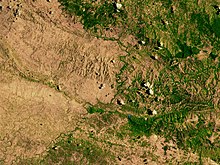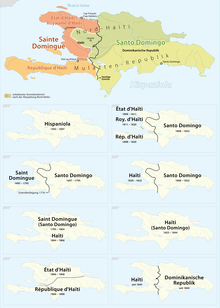Dominican Republic–Haiti border

The Dominican Republic–Haiti border is an international border between the Dominican Republic and the Republic of Haiti on the island of Hispaniola. Extending from the Caribbean Sea in the south to the Atlantic Ocean in the north, the 391 km border was agreed upon in the 1929 Dominican–Haitian border treaty.
The island was first formally divided in 1697 as part of the Peace of Ryswick, under which Spain ceded to France the western portion it had seized by force earlier in the century. In 1621, England made an unsuccessful attempt to take over both sides of the island. In the early 20th century, the United States occupied both countries, and made numerous changes to the border. The Dominican Republic comprises approximately the eastern two-thirds of the island and the Republic of Haiti the western third.[1]
Description



The border starts in the north at the Boca del Río Dajabón where the
History

The division of the island of Hispaniola dates to the 16th and 17th centuries, when the Spanish colonised the eastern part of the island and the French colonised the western part of the island. After decades of hostilities, mutual acknowledgement by France and Spain of their respective colonies,
The poor relations between the two states were hampered by disputes over sections of the border, which was not finally delimited until 1929.[4] A subsequent commission set about conducting on-the-ground demarcation, however there were continuing disputes over certain sections of the boundary.[4] These were allocated via a treaty signed on 27 February 1935, with a final border treaty being signed on 9 March 1936.[4] Despite this, Dominican dictator Rafael Trujillo subsequently launched a wave of anti-Haitian violence in 1937, culminating in the Parsley massacre in which thousands of Haitians living in the DR were forced across the border or killed.[13][14] Though relations since then have improved, the two countries remain deeply divided on demographic, political, racial, cultural and economic lines.[15][16] Haiti's political situation is volatile, and the economy of the Dominican Republic is ten times larger than that of Haiti, prompting many Haitians to move to the DR seeking better opportunities, where they are often the subject of discrimination.[17][18]
As of 2023[update], over 500,000 Haitians live in the Dominican Republic, which has a population of about 11 million.[19] According to human rights activists, mistreatment of Haitians has increased under DR president Luis Abinader, who took office in August 2020. Observers said that a spike in deportations occurred in 2021, with more than 31,000 sent back to Haiti. Numerous anti-Haitian actions by the DR government were cited, including separation of children from their parents and deportation of pregnant women; racial profiling (most Haitians are black, Dominicans identify as mixed race); suspension of Haitian student visas, requiring Haitian migrants to register their location, and prohibited companies from hiring migrants for more than 20% of their workforce.[20]
Border wall
In February 2023, construction was started on a border wall that will cover 164 kilometers (102 miles) of the 392-kilometer (244 miles) border with Haiti.[21][22] The 3.9 meters (12.8 feet) high wall is 20-centimeter-thick concrete topped by a metal mesh, and contains fiber optics for communications, movement sensors, cameras, radars and drones.[21][23] The project includes 70 watchtowers and 41 access gates for patrolling.[21] This $32 million project will be the second longest border wall in the Americas, after the US-Mexico wall.[22] Proposals for a wall came from several Dominican politicians, including Ramfis Trujillo, grandson of Dominican dictator Rafael Trujillo, and current president Luis Abinader, as a measure to reduce irregular migration from Haiti and smuggling.[24][21] The idea is supported by the majority of the Dominican population.[25] Dominican officials claim the wall will slow the illegal drug trade and reduce the chance of gang violence in Haiti from spreading to the Dominican Republic. The project is controversial, with claims that it will do little to reduce illegal migration, will encourage bribery of Dominican Republic soldiers, and will become a source of conflict.[23] The wall is being built in Dominican Republic territory, allowing DR soldiers to patrol on both sides. This has become a source of tension, arising from claims that the area on the Haiti-facing side is a no-man's-land, or has been ceded to Haiti by virtue of the wall.[26]
Water rights dispute and border closure
On September 15, 2023, a dispute over water rights in the Dajabón River (also called Massacre River) led the Dominican Republic to close the border. Construction by Haitian workers was underway on a canal intended to irrigate approximately 7,400 acres in Haiti's Maribaroux plain. Dominican officials claimed the canal project violates a 1929 treaty which states both countries may use the water but not alter the river's natural course.[19][27] On October 11, the border was partially reopened to essential goods such as food and medicine, yet still closed for migrants. Abinader maintained the ban on issuing visas regardless of health, education, or work purposes.[28] The United States Department of Agriculture reported that the Dominican Republic had lost $21 million in its agricultural trade with Haiti due to its border closure. Haiti is the Dominican Republic's second-largest export destination, with an annual profit of $430 to $566 million.[29] Despite the reopening on the Dominican side of the border, the canal has become a movement, sparking Haitians to boycott Dominican goods.[28] [29] On October 30, 2023, the air border with Haiti was reopened.[30]
Settlements near the border
Dominican Republic

Haiti

- Nan Contrée
- Capotille
- Ouanaminthe
- Parc Dubois
- Malpasse
- Belladère
- Fonds-Verrettes
- Banane
- Anse-à-Pitres
Border crossings
There are four official crossing points and many more unofficial ones.[31] The four official crossing points are: Malpasse-Jimaní, Ouanaminthe-Dajabón, Anse-à-Pitres-Pedernales and Belladère-Comendador.[32][6]
Gallery
-
Map of the border - north
-
Map of the border - north central
-
Map of the border - south central
-
Map of the border - south
See also
References
- ^ "Haiti". CIA World Factbook. Retrieved 2 October 2020.
- ^ Clammer, Paul, (2016) Bradt Travel Guide – Haiti, p.11
- ^ a b "Dominican Republic – The first colony". Country Studies. Library of Congress; Federal Research Division. Retrieved 19 June 2006.
- ^ a b c d e "International Boundary Study No. 5 - Dominican Republic – Haiti Boundary" (PDF). US Department of State. 23 May 1961. Retrieved 2 October 2020.
- OL 365453M.
- ^ a b "The Haitian-Dominican Borderlands" (PDF). Our Border. Retrieved 2 October 2020.
- ^ "The birth of Haitian-Dominican border « Our Border | Nuestra Frontera | Fwontyè Nou". nuestrafrontera.org. Archived from the original on October 20, 2009.
- ^ ""A Brief History of Dessalines", 1825 Missionary Journal". Webster University. Archived from the original on 28 December 2005. Retrieved 24 July 2013.
- ^ Clammer, Paul, (2016) Bradt Travel Guide – Haiti, p. 209
- ]
- ^ United States Geographic Board, ed. (1890–1891). First Report of the United States - Board of Geographic Names 1890-1891. Washington Government Printing Office. p. 45. Retrieved 13 September 2015.
haiti; island.
- ^ "World Leaders Index: Dominican Republic". Archived from the original on 2015-06-20. Retrieved 2015-04-26.
- S2CID 143872486. Retrieved 26 June 2020.
- JSTOR 24585148.
- ^ Silver, Alexandra (2010-01-19). "Why Haiti and the Dominican Republic Are So Different". Time. Archived from the original on 2015-06-12.
- ^ Lancer, Jalisco. "The Conflict Between Haiti and the Dominican Republic". AllEmpires. Archived from the original on 2015-12-11. Retrieved 2015-12-12.
- ^ Schaaf, Bryan (2009-05-21). "Haiti and the Dominican Republic: Same Island, Different Worlds". Haiti Innovation. Washington, DC. Archived from the original on 2015-01-04.
- ^ "The Dominican Republic and Haiti: one island, two nations, lots of trouble". The Economist. May 14, 2016. Retrieved Nov 22, 2023.
- ^ Washington Post. Retrieved Dec 25, 2023.
- ^ "Dominican Republic expels, mistreats Haitians, activists say". AP News. 2021-12-06. Retrieved 2023-12-18.
- ^ a b c d Abiu, Ezequiel; Jorgic, Drazen (February 20, 2022). "Dominican Republic begins building border wall with Haiti". Reuters. Retrieved Nov 22, 2023.
- ^ a b Balbi, Danielle (September 28, 2022). "A 101-Mile Wall Goes Up to Block Haitians Pouring Over Border". Bloomberg News. Retrieved Nov 22, 2023.
- ^ a b Parkin Daniels, Joe (25 Feb 2022). "Dominican Republic starts work on border wall with Haiti". The Guardian. Retrieved Nov 22, 2023.
- ^ "Rafael Trujillo's grandson Ramfis wants build a wall between Haiti and the Dominican Republic".
- ^ "Ciudadanos dominicanos quieren aportar para la construcción de verja en la frontera". 28 February 2021.
- ^ Charles, Jacqueline (November 8, 2023). "Dominicans built a wall to keep Haitians out. Now it's adding to border tensions". Miami Herald. Retrieved Nov 22, 2023.
- ^ Klimnt, Alex (17 September 2023). "Dispute over water rights threatens to close Haiti's border". GZERO. Retrieved 2023-09-17.
- ^ AP News. Retrieved Nov 22, 2023.
- ^ a b Mayol, Virgilio. Cledo, Fritzner. Closure of Haiti Dominican Republic Border Impacts Food Security-Bilateral Trade and U.S Agricultural Imports. United States Department of Agriculture (USDA), 13 Oct. 2023
- ^ "Dominican Republic travel advice". Government of Canada. November 3, 2023. Retrieved Nov 22, 2023.
- ^ "Haiti - Social : 17,271 border crossings between Haiti and the DR recorded in 8 days". Haiti Libre. Retrieved 2 October 2020.
- ^ Clammer, Paul, (2016) Bradt Travel Guide – Haiti, p.51-2



